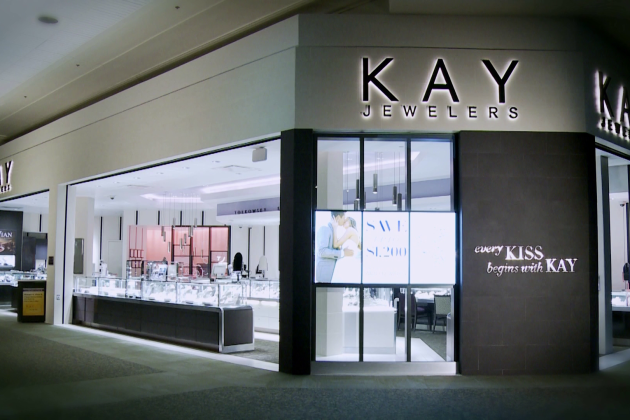‘No Longer a Dated Mall Retailer’: Signet CEO Outlines Progress

In its three-to-five-year transformation strategy, Signet Jewelers is hitting targets ahead of schedule, has updated financial goals, and expects engagement-related jewelry purchases to rebound beginning in the fourth quarter of this year.
“We are setting a $9 billion to $10 billion revenue target, which we’re confident we can achieve, particularly as engagements return to normal levels, and as services and accessible luxury, including our digitally native brands, contribute greater and faster growth,” Signet chief executive officer Virginia C. Drosos said at the jewelry retailer’s investor day held Tuesday in New York. Signet considers accessible luxury jewelry — sold at its Jared, Blue Nile, James Allen and Diamonds Direct — as generally in the $1,000 to $3,000 price range.
More from WWD
Signet, which operates Zales, Kay, Jared, Blue Nile, James Allen, Diamonds Direct, Banter by Piercing Pagoda, Peoples, H. Samuel, Ernest Jones and Rocksbox, reached more than $7.84 billion in sales last year. Sales are projected at $7.67 billion to $7.84 billion for this year. Signet’s transformation strategy began in fiscal 2019.
“We expect approximately $600 million from the engagement tailwinds which will begin in Q4 of fiscal ’24 and continue through fiscal ’27,” Drosos told investors. “A large portion of this growth will come in our ‘big business’ banners, Kay and Zales. As we’ve positioned these two banners to target different customers, we’ve also differentiated their assortments, marketing, digital and store experiences and loyalty offerings, enabling us to grow both simultaneously.” The company expects engagement purchases to grow approximately 25 percent by calendar year 2026, returning to prior engagement levels.
Among the goals cited by the CEO: continuing to deliver double-digit non-GAAP annual operating margin, with an updated range of 11 to 12 percent; growing U.S. market share to 11 to 12 percent, from 9.7 percent currently; and annual non-GAAP earnings per share in a range of $14 to $16, which contemplates continued investment in the business and dividend growth but does not include the impact of share buybacks.
Last year, Signet earned non-GAAP diluted earnings per share of $11.80 and reported non-GAAP operating margin at 10.8 percent. Fourth-quarter comparable sales declined 9.1 percent to $2.67 billion and non-GAAP operating income slipped to $404.7 million from $411 million in the year-ago quarter.

Drosos said Signet intends to continue using share repurchasing “as a healthy part of our capital allocation given our remaining authorization of approximately $765 million.”
Much of her presentation centered on Signet’s financial condition and dispelling what she said were “misconceptions” about the company, in particular that its portfolio of jewelry brands aren’t differentiated enough, and that Signet is a dated, mall-based jewelry retailer.
“Perceptions don’t always reflect the reality,” Drosos told investors. “There’s a belief that Signet is a short-term COVID[-19] beneficiary and not a long-term growth story. The reality is that while we did benefit in 2021 from COVID[-19] related stimulus, largely in lower-price fashion, we also experienced significant headwinds in bridal, first in weddings and now in engagements,” as a result of lockdowns and reduced dating during the pandemic. “Our primary COVID[-19] benefit will come as engagements begin recovering in Q4 this year.”
“Signet is no longer a dated mall retailer,” Drosos told investors. “In the past five years we optimized our fleet, closing more than 1,000 doors and reducing our footprint 21 percent primarily in lower-grade malls. Today, 40 percent of our doors and more than 50 percent of our sales are off-mall. Fifty percent of our doors are in A and B malls and 10 percent in C malls that are highly productive. We have no exposure to D malls. Twenty percent of our sales are from online, up from 5 percent prior to [starting] our transformation.
“When we began our transformation, we had considerable overlap and were reaching approximately 37 percent of the available market. Today, through our portfolio differentiation and expansion, we are reaching 80 percent and are expanding the market as we appeal to younger, more diverse, more affluent, and more digitally savvy customers.”
Apparently, investors liked what they heard as Signet’s stock price rose 3.6 percent, or $2.72 to $78.12 at the closing bell Tuesday.
Drosos characterized jewelry retailing as “much less cyclical than most of retail. Half of our merchandise sales are in bridal, which has a long, sustainable history of stability and predictable growth that we’re confident will return after a short-term COVID[-19] impact.
“We’ve been modernizing our company in every way, including talent. The average tenure of our senior leaders is 4.5 years. We bring a diverse mix of industry and technical expertise in areas that are important competitive advantages. Together, we’ve not only established our growth trajectory but have also systematically disposed of the overhangs previously holding Signet back, including litigation, high debt leverage and cultural issues.
“From fiscal 2019 Signet’s financial health has gone from being an impediment, preventing appropriate investments in the businesses and talent, to becoming a significant a competitive advantage. In times of market growth or decline, we are investing to advance our capabilities further,” Drosos said.
Recapping accomplishments during the transformation so far, Drosos said that from fiscal 2019 to fiscal 2023 the company invested more than $750 million in capital to fuel strategies; that the company returned $1.4 billion in cash to shareholders through share repurchases and dividends and paid nearly $900 million in cash for two acquisitions, Blue Nile and Diamonds Direct. Drosos also said the company paid down more than half a billion in debt, reducing leverage from a high of four times earnings before interest, taxes, depreciation and amortization, to a “very healthy” two times. Liquidity, she added, has tripled from $880 million to $2.6 billion.
Two years ago, Drosos disclosed Signet’s transformation priorities over its next three to five years. She cited initiatives in product innovations, services, supply chain and marketing, connecting physical and virtual operations.
“We want you to have the same confidence in Signet’s growth potential that we have,” Drosos told investors. “We are a differentiated retailer with scale and competitive advantages in an attractive and fragmented market.”
Best of WWD
